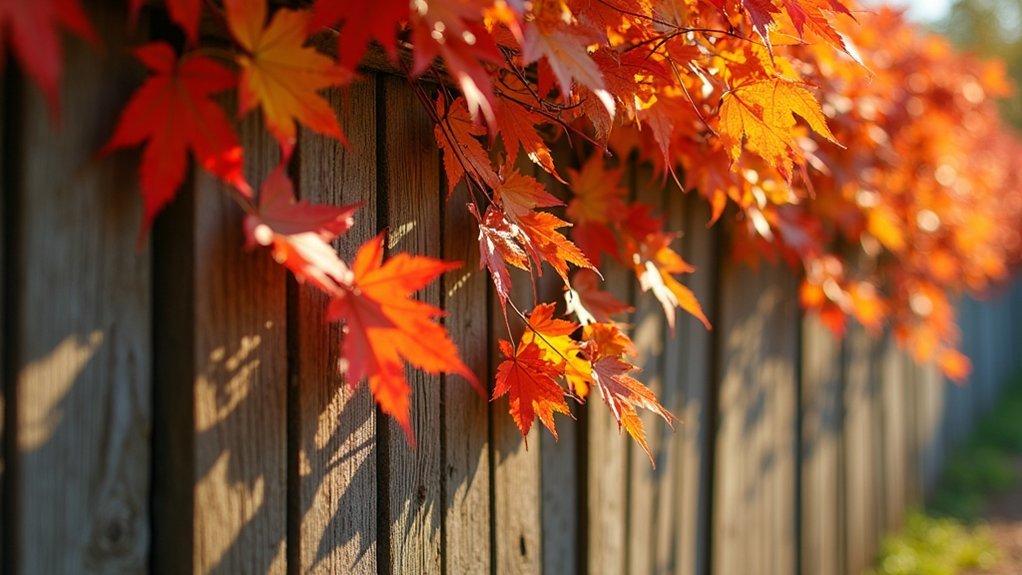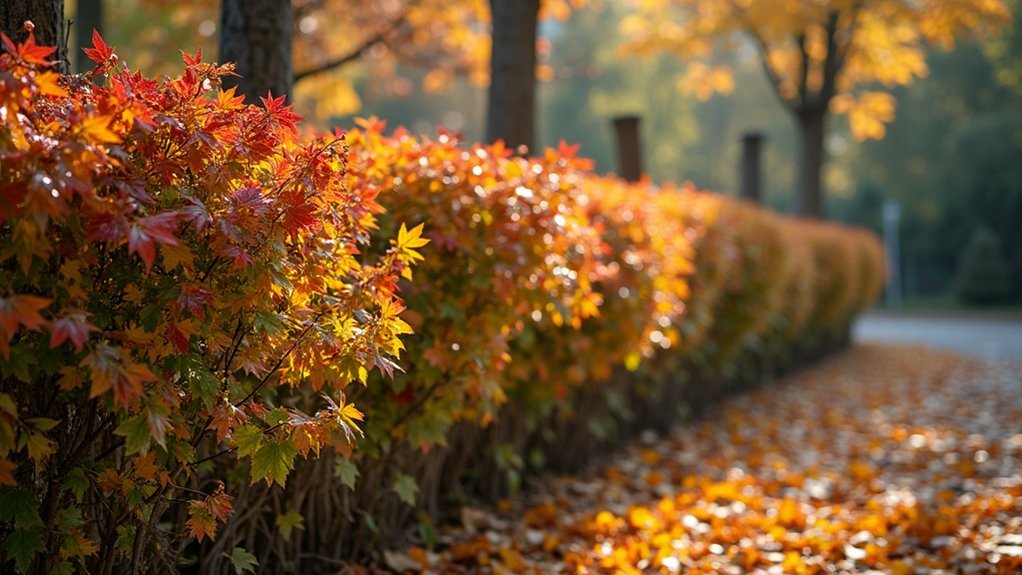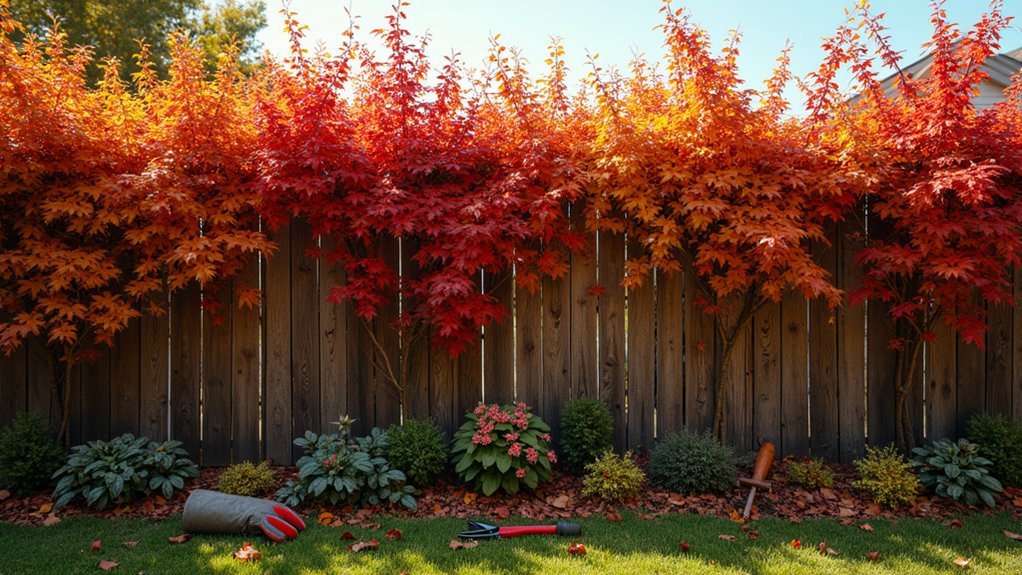Fall is prime time to prepare your living fence for winter. Conduct thorough inspections of posts and panels, tighten hardware, and replace rusted fasteners. Prune diseased branches and create a tapered profile for wind resistance. Apply nitrogen-rich fertilizer and add an 8-inch layer of mulch around roots. Clear drainage paths to prevent water pooling, and install temporary supports for vulnerable sections. These simple steps now will protect your natural barrier and benefit local wildlife throughout the colder months.
Pre-Autumn Structural Inspections and Repairs

As autumn approaches, conducting a thorough structural inspection of your living fence guarantees it will withstand the coming seasonal challenges.
Begin by checking posts for rot, rust, or misalignment using a level. Confirm they’re securely anchored without wobbling.
Examine panels and rails for warping, cracks, or loose connections. Tighten any hardware and replace rusted fasteners with galvanized or stainless steel alternatives.
Inspect panels for damage and secure all connections, upgrading to corrosion-resistant hardware where needed.
Remove vegetation that might compromise stability.
Don’t overlook the foundation—inspect concrete footings for cracks and confirm proper drainage around posts. Soil should slope away to prevent water pooling.
Prioritize repairs immediately for posts with significant damage. Use pressure-treated replacements rated for ground contact, and apply preservatives to cut ends before installation.
Document all maintenance for future reference. Gates should receive special attention during inspection, ensuring proper functionality and alignment of hinges and locks for optimal security.
Selecting Cold-Hardy Plants for Year-Round Privacy
When planning your living fence for year-round privacy, focus on cold-hardy evergreens like Arborvitae and Yew that maintain their screening ability through winter’s harshest conditions.
You’ll find native varieties such as American Juniper and Eastern Red Cedar offer excellent resilience while supporting local ecosystems better than imported alternatives.
These indigenous options won’t just survive—they’ll thrive in your landscape while providing consistent privacy across all seasons. Among the best choices is the Emerald Green Arborvitae, which reaches 12 to 15 feet tall and thrives in zones 2 to 7, making it ideal for colder climates.
Best Evergreen Options
Selecting the right cold-hardy evergreens forms the foundation of a successful living fence that stands strong through winter’s challenges. For northern landscapes, American Arborvitae offers rapid growth and dense foliage in zones 2-8, creating effective windbreaks within a few seasons.
Western Arborvitae ‘Ember Waves’ brings dramatic winter interest with its glowing orange foliage in zones 5-8. For colder regions, Wichita Blue Juniper provides exceptional hardiness down to zone 3 with stunning silver-blue foliage.
- Structural advantages: Look for plants with frost-resistant roots and flexible wood that withstand heavy snow loads without breaking.
- Optimal conditions: Plant in full sun with well-drained soil and 3-4″ of mulch to regulate temperature.
- Spacing matters: Position plants 3-5′ apart for privacy without compromising airflow or future growth.
Remember to water thoroughly in late autumn before ground freeze to prevent winter desiccation.
Native Varieties Shine
Throughout North America’s diverse climate zones, native varieties offer unmatched resilience for living fences that provide year-round privacy. Eastern Redcedar and American Holly stand out with their dense growth habits and natural pest resistance, creating effective visual barriers with minimal maintenance.
Before planting, check your soil’s pH—Sweet Pepperbush thrives in acidic conditions (4.5-6.5), while Red Chokeberry adapts to various soils. Space specimens according to mature width, allowing 5-8 feet between American Holly plants.
For winter interest, combine berry-producing shrubs like Ilex opaca with structural standouts like Juniperus virginiana. These natives don’t just block sightlines—they support wildlife too. Our collection includes Blue Arrow Rocky Mountain Juniper, which offers excellent privacy with its dense foliage at a 17% discount from regular pricing.
Leave seed heads intact and lower branches unpruned to provide critical food and shelter for birds when resources are scarce.
Essential Pruning and Maintenance Tasks for Fall

As temperatures begin to cool, your living fence requires focused attention to prepare it for the winter months ahead. Prune in early fall using sharp shears to prevent damage while removing diseased branches and maintaining proper shape. This timing prevents unwanted new growth before winter’s arrival and helps preserve your fence’s structural integrity.
- Check soil quality and apply mulch around the base to retain moisture and suppress competing weeds.
- Ascertain adequate spacing between plants to promote proper air circulation, reducing disease risk.
- Inspect thoroughly for pests like scale insects and treat promptly with appropriate organic or chemical solutions.
Most hedges need annual pruning to prevent becoming top-heavy. Consider planting native species that support local wildlife while requiring less intensive maintenance. By establishing a consistent maintenance routine now, you’ll support your living fence through winter and set it up for healthy spring growth.
Protecting Your Living Fence From Autumn Storms
As autumn storms approach, you’ll need to reinforce your living fence by securing stakes and adding cross-supports at vulnerable points.
Prune your hedge with wind resistance in mind, creating a tapered shape that allows gusts to flow through rather than push against a flat surface.
Don’t wait until weather warnings appear—prepare emergency materials like quick-set supports, protective covers, and temporary bracing that you can deploy when severe conditions threaten your living boundary. Make sure to clear debris around your living fence to prevent additional weight and potential damage during storms.
Reinforcing Support Structures
When autumn storms threaten your living fence, reinforcing support structures becomes essential to prevent damage and preserve your investment.
Examine your structural frames for weak points and add bracing where needed. Wooden or metal frames should be sturdy enough to handle the increased weight of mature plants plus potential snow loads.
Ensure your support system has proper drainage to prevent water accumulation that weakens foundations. Apply protective coatings to metal components and consider weather-resistant woods like cedar or cypress for wooden elements. Remember that climbing vines can become exceptionally heavy once established, requiring robust structural reinforcement before autumn weather arrives.
- Secure plants firmly to supports using cable ties or wire to prevent detachment during high winds
- Apply mulch around base structures to stabilize soil and reduce erosion
- Conduct rigorous pre-autumn inspections and repair any damages immediately
Wind-Resistant Pruning Techniques
Three critical pruning techniques will transform your living fence into a storm-resistant barrier this autumn.
First, practice selective thinning by removing 20-30% of the dense interior branches. This creates calculated gaps that allow wind to filter through rather than push against a solid surface. Use hand pruners for this detailed work, ensuring clean cuts that heal properly.
Second, remove all dead or weak branches immediately. These vulnerable points become hazardous projectiles during storms and compromise your fence’s structural integrity.
Finally, encourage lateral growth by pruning the tops of plants slightly more than the sides. This creates a tapered profile that naturally deflects wind upward and reduces the force exerted on your living fence.
Time these pruning activities before the first major storms arrive, giving your plants several weeks to heal and strengthen their remaining branches for maximum wind resistance.
Emergency Weather Preparations
While proper pruning provides fundamental protection, autumn’s unpredictable weather demands additional emergency preparations for your living fence.
When forecasts warn of severe storms, install temporary support stakes at vulnerable sections and secure any loose areas with garden twine or plant-friendly straps. Clear drainage paths around your fence’s base to prevent water pooling that can weaken roots during heavy rains. Consider reinforcing fence posts with concrete to provide extra stability during high winds.
- Create a storm kit with emergency supports, waterproof tape, and quick-setting fence post cement for rapid repairs
- Establish a pre-storm routine: move potted plants away from the fence, clear gutters above fence lines, and check for dead branches
- Take “before” photos of your fence to help identify storm damage for insurance claims and document needed repairs
Soil Preparation and Root Care Before Winter
As frost-filled days approach, preparing the soil around your living fence becomes essential for its winter survival and spring revival.
Loosen soil to a depth of 8-12 inches to encourage deeper root growth, then clear away weeds and debris that compete for nutrients.
Apply nitrogen-rich fertilizers based on soil test results.
Create a protective environment by adding an 8-inch layer of insulating mulch around root areas—this conserves moisture while shielding against frost damage.
For areas prone to waterlogging, improve drainage by incorporating compost, perlite, or peat moss.
Consider wrapping root balls or using burlap coverings for vulnerable sections of your fence.
Build small soil rings to direct rainwater toward roots, and dig shallow trenches to prevent water pooling.
The autumn months are ideal for controlling competing vegetation to ensure your living snow fence thrives in the coming seasons.
Monitor regularly throughout winter to address emerging issues.
Wildlife Benefits of Well-Maintained Living Barriers

Living fences offer remarkable sanctuaries for local wildlife when properly maintained through autumn and winter. Your thoughtful care creates crucial noise reduction zones where birds can communicate and breed successfully away from urban disturbances. The various flowering plants can form pollinator pathways that help bees and butterflies navigate through urban areas.
Dense, healthy foliage provides essential shelter against winter’s harsh conditions while supporting diverse nesting opportunities.
- Properly pruned living fences maintain wildlife corridors that connect fragmented habitats, enabling safe migration and genetic diversity.
- Leaving some fruit unharvested on flowering species guarantees food availability during scarce winter months.
- Creating varied structural complexity in your fence attracts a wider range of beneficial species, from insects to small mammals.
Frequently Asked Questions
How Long Does a Newly Planted Living Fence Take to Establish?
Your living fence will take 3-5 years to fully establish. You’ll see initial root development within months, but patience is key as growth rates depend on your climate, soil quality, and chosen plant species.
Can I Trim Flowering Shrubs in Autumn Without Affecting Spring Blooms?
No, you shouldn’t trim spring-flowering shrubs in autumn as they’ve already set next year’s flower buds on old wood. Wait until after they bloom in spring to prune without sacrificing flowers.
What Spacing Between Plants Creates the Most Effective Privacy Barrier?
For the most effective privacy barrier, you’ll want to space plants at half their mature width. If you’re in a hurry, use staggered rows placed at one-quarter mature width apart for denser coverage.
Are Living Fences Effective at Deterring Neighborhood Pets and Wildlife?
Living fences can deter most pets and some wildlife if they’re properly designed. You’ll need dense plantings for dogs, thorny species for cats, and taller structures (over 42 inches) to prevent deer from jumping over.
How Do Living Fences Compare to Traditional Fences in Maintenance Costs?
You’ll spend more time maintaining living fences through pruning and watering compared to traditional options like vinyl. However, you won’t face replacement costs that traditional fences require every 15-30 years.
In Summary
Your living fence isn’t just a boundary—it’s a vibrant ecosystem that needs your attention as seasons change. By preparing it for autumn with proper inspections, pruning, and soil care, you’ll enjoy privacy and beauty year-round. Don’t forget that your living barrier provides essential habitat for wildlife during colder months. Take these steps now, and you’ll be rewarded with a healthy, resilient fence come spring.





Leave a Reply